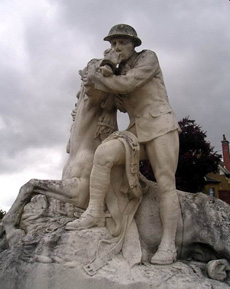 I meant to share the story of this touching monument on Memorial Day. Here it is three weeks later.
I meant to share the story of this touching monument on Memorial Day. Here it is three weeks later.
Created by the French sculptor Henri-Desire Gauquie, the statue stands in the center of the small village of Chipilly, located in the Somme River valley of northern France, and depicts a World War I British soldier cradling the head of his wounded horse.
Chipilly was a key objective in the Battle of Amiens, which began on August 8, 1918 and was the opening phase of the Allied offensive that ultimately led to the end of World War I. The Germans on Chipilly Spur, a steep wooded ridge, commanded a wide field of fire to the south of the Somme, and their fire held up Allied forces until Australian troops slipped across the river and captured Chipilly on August 9.
Although Amiens was one of the first major battles involving armored vehicles and marked the end of trench warfare on the Western Front, horses and mules were still an important means of transportation until the armistice was signed on November 11, 1918.
James Pitcairn, trained as a horse artilleryman with the Canadian Army and sent to France as a member of the 52nd Field Artillery, 5th Division, saw service at Amiens and recalled in an interview with Veterans Affairs Canada:
We lost an awful lot of horses. See, they couldn’t duck. And then, at various times when we were advancing and where a horse had been killed, we saw where the Germans were cutting steaks out of them. We saw that quite often. Horse meat is eaten a lot in those countries, and we saw a lot of horses cut open that were killed. And, of course, we saw our own horses get killed. I felt more for a horse than I did for a man for some strange reason, at the time, just at the time. I thought, these poor things are being dragged here. We know what we’re doing, they don’t.
The Battle of Amiens was also notable for the large number of surrendering German forces, which led General Quartermaster Erich Ludendorff to describe it as “the Black Day of the German Army.” While 22,200 Allied soldiers were counted dead, wounded, or missing,Germany suffered 74,000 casualties. It is estimated that 8 million horses lost their lives in service during World War I.
